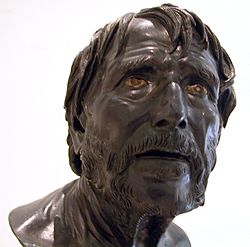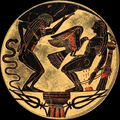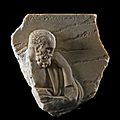Theogony facts for kids

The Theogony (pronounced Thee-OG-uh-nee) is a very old poem written by a Greek poet named Hesiod. It was created around the 8th or 7th century BC. The word "Theogony" comes from Greek and means "the birth of the gods." This poem uses the same type of Ancient Greek language as the famous writer Homer. Today, we call this language the Epic dialect. The Theogony is one of the oldest known sources of Greek mythology, right after Homer's great poems, the Iliad and the Odyssey.
What is Theogony About?
The Theogony brings together many different Greek stories and traditions. It tells the amazing tale of how the gods came into being. It also explains how they gained lasting power over the entire universe. This poem is the first Greek myth that describes the creation of the cosmos.
The Beginning: Chaos and Creation
In the very beginning, the universe was in a state of chaos. Imagine a dark, endless empty space. This chaos was not just nothingness; it was a powerful, undefined void. From this divine chaos, everything else in the universe began to appear. The poem describes how the first gods and the world itself slowly formed from this original state.
Images for kids
-
The nine muses on a Roman sarcophagus (second century AD) at the Louvre, Paris.
-
The Birth of Minerva by René-Antoine Houasse (before 1688).
-
A Laconic bowl showing Prometheus and Atlas receiving their punishments, around 550 B.C.
-
A stele of Anaximander, an ancient Greek natural philosopher.
See also
 In Spanish: Teogonía para niños
In Spanish: Teogonía para niños








